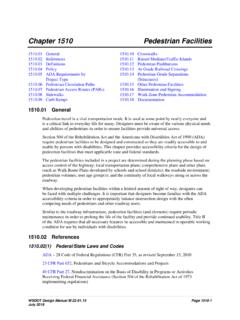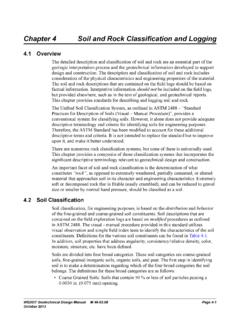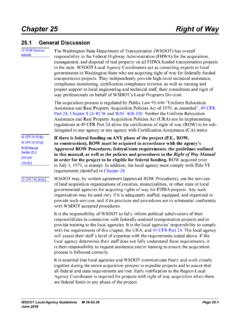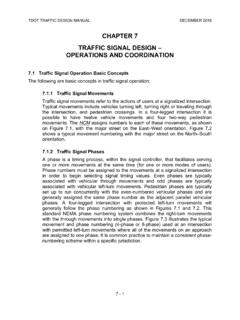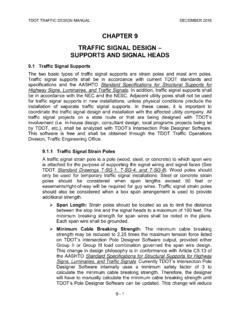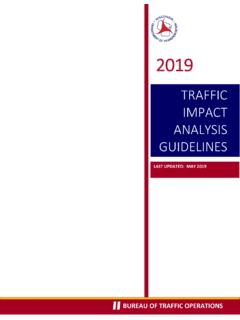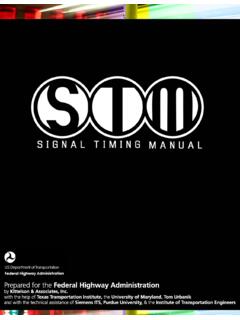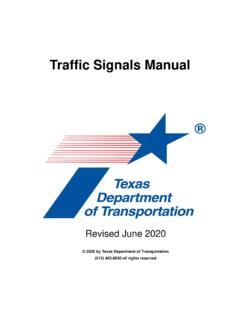Transcription of Chapter 1310 Intersections - Washington State Department ...
1 WSDOT design Manual M Page 1310-1 July 2017 Chapter 1310 Intersections General design Considerations design Elements U-Turns Intersection Sight Distance Signing and Delineation Procedures Documentation References General Intersections are a critical part of Washington State Department of Transportation (WSDOT) highway design because of increased conflict potential. traffic and driver characteristics, bicycle and pedestrian needs, physical features, and economics are considered during the scoping and design stages to develop channelization and traffic control to provide multimodal traffic flow through Intersections .
2 See chapters in the 1100 series for instruction on multimodal practical design , including identifying project needs, context, design controls, modal performance, alternatives analysis, and design element dimensioning. This Chapter provides guidance for designing Intersections , including ramp terminals. Refer to the following chapters for additional information: Chapter Subject 1103 design controls 1106 design element dimensions 1230 Geometric cross section 1300 Intersection control type 1320 Roundabouts 1330 traffic signals 1340 Driveways 1360 Interchanges 1510 Pedestrian facilities 1520 Roadway bicycle facilities For assistance with intersection design , contact the Headquarters (HQ) design Office.
3 Intersections Chapter 1310 Page 1310-2 WSDOT design Manual M July 2017 design Considerations Consider all potential users of the facility in the design of an intersection. This involves addressing the needs of a diverse mix of user groups, including passenger cars, heavy vehicles of varying classifications, bicycles, and pedestrians. Often, meeting the needs of one user group results in a compromise in service to others. Intersection design balances these competing needs, resulting in appropriate levels of operation for all users.
4 In addition to reducing the number of conflicts, minimize the conflict area as much as possible while still providing for the design vehicle (see Chapter 1103). This is done to control the speed of turning vehicles and reduce the area of exposure for vehicles, bicycles, and pedestrians. For additional information on pedestrian needs, see Chapter 1510. For Intersections with shared-use paths, see Chapter 1515. For bicycle considerations at Intersections , see Chapter 1520. (1) Non-Geometric Considerations Geometric design considerations, such as sight distance and intersection angle, are important.
5 Equally important are perception, contrast, and a driver s age. Perception is a factor in the majority of crashes. Regardless of the type of intersection, the function depends on the driver s ability to perceive what is happening with respect to the surroundings and other vehicles. When choosing an acceptable gap, the driver first identifies the approaching vehicle and then determines its speed. The driver uses visual clues provided by the immediate surroundings in making these decisions. Thus, given equal sight distance, it may be easier for the driver to judge a vehicle s oncoming speed when there are more objects to pass by in the driver s line of sight.
6 Contrast allows drivers to discern one object from another. (2) Intersection Angle and Roadway Alignment An important intersection design characteristic is the intersection angle. The desirable intersection angle is 90 , with 60 to 120 allowed. Do not put angle points on the roadway alignments within intersection areas or on the through roadway alignment within 100 feet of the edge of traveled way of a crossroad. However, angle points within the intersection are allowed at Intersections with a minor through movement, such as at a ramp terminal (see Exhibit 1310-2).
7 When feasible, locate Intersections such that curves do not begin or end within the intersection area. It is desirable to locate the PC and PT 250 feet or more from the intersection so that a driver can settle into the curve before the gap in the striping for the intersection area. Do not locate short curves where both the PC and PT are within the intersection area. Chapter 1310 Intersections WSDOT design Manual M Page 1310-3 July 2017 (3) Lane Alignment It is desirable that entering through traffic is aligned with the exit lanes.
8 However, the entering and exit lanes may be offset up to 6 feet when the following conditions are met: Illumination is provided. The intersection is not within a horizontal curve, nor is it within a crest vertical curve. The taper rates provided in Exhibit 1310-1 are used. There is a posted speed of 55 mph or less. Consider dotted extension lines that continue through the intersection. Exhibit 1310-1 Lane Alignment Taper Rate (4) Intersection Spacing Provide intersection spacing for efficient operation of the highway.
9 The minimum design intersection spacing for highways with limited access control is covered in Chapter 530. For other highways, the minimum design intersection spacing is dependent on the managed access highway class. (See Chapter 540 for minimum intersection spacing on managed access highways.) As a minimum, provide enough space between Intersections for left-turn lanes and storage length. Space signalized Intersections and Intersections expected to be signalized to maintain efficient signal operation. Space Intersections so that queues will not block an adjacent intersection.
10 Posted Speed Taper Rate 55 mph 55:1 50 mph 50:1 45 mph 45:1 40 mph 27:1 35 mph 21:1 30 mph 15:1 25 mph 11:1 See table for lane alignment taper ft max offset allowedIntersections Chapter 1310 Page 1310-4 WSDOT design Manual M July 2017 Evaluate existing Intersections that are spaced less than shown in Chapters 530 and 540. Also, evaluate closing or restricting movements at Intersections with operational issues. Document the spacing of existing Intersections that will remain in place and the effects of the spacing on operation, capacity, and circulation.


